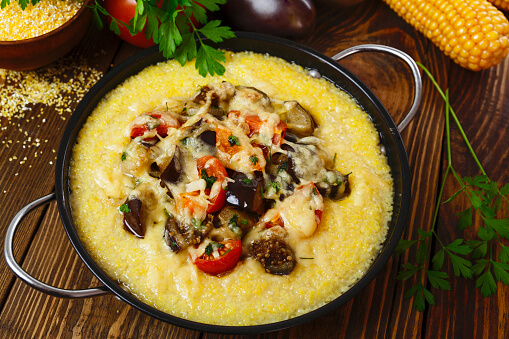Forget the Cornbread. Try Polenta!
8 years ago | Nutrition
By Joy Stephenson-Laws, JD, Founder
As we approach the holidays and cooler weather, many of us may be tempted to start turning to our favorite comfort foods: mac n’ cheese, mashed potatoes, apple pie, pizza, grilled cheese sandwiches and more. One of my personal favorite comfort foods is cornbread, which sometimes has a lot of added sugar and butter.
But I think I may have found an option, which might encourage me to kick my cornbread cravings. Not only is it gluten-free and low calorie, but it is also delicious and very versatile. If you’ve never had polenta, I hope I can entice you to try this guilt-free comfort food.
Polenta is usually served as a porridge dish of boiled, ground cornmeal made from yellow corn. Grits, which are popular in American Southern cuisine, are usually made from white corn. Polenta is a staple in Northern Italy, and this dish reportedly originated there. It was often called peasant food, because it was inexpensive and something you could easily produce in large quantities. But polenta is very rich flavor-wise.
Grits are usually made from a type of corn called dent corn (also called field corn and very common in the U.S., more common than sweet corn). Most commercial cornmeal is made from yellow or white dent corn. Traditional Italian polenta is usually made from flint corn. You can make polenta from any type of corn, but many culinary experts report flint corn will make the dish more authentic and create the delicious, creamy texture that makes polenta so comforting and inviting.
If you cook polenta yourself, use water, vegetable or chicken stock or almond milk to keep it light and healthy. It will usually take about 45 minutes to an hour to make. But it is well worth it, and you can use it in so many ways. Serve it as a simple side dish, or use it as the “rice” in a stir fry or the “noodles” in a pasta dish. It is recommended to use coarser polenta when serving it with sauces. You can even bake healthy polenta cakes (use fine grained polenta for baking). You can also cool and set polenta in a baking sheet in the refrigerator, cut into slices and bake it, grill it and more.
For more ways to cook polenta in a healthy way, click here. You can even use polenta to make pizza crust.
If you’re short on time, you can also buy pre-cooked polenta in the grocery store. Just be sure to look for a healthier option that does not have a lot of added cream and butter. I recommend buying organic polenta.
If the thought of a creamy bowl of polenta does not make your mouth water, maybe you will be more drawn to some of the benefits of eating this delicious dish.
Polenta is uniquely good for you because...
Polenta is a low fat carbohydrate. One cup of polenta will usually cost you about 146 calories (generally less calories than pasta and rice) and just 1 gram of fat. Polenta is also very filling and a good source of energy that will sustain you for a long period of time.
Polenta is rich in fiber. Fiber helps relieve constipation, irritable bowel syndrome (IBS) and may even help prevent colon cancer. It can help you feel fuller longer and reduce cravings and hunger pangs.
Polenta is a meat-free source of protein. For vegans and vegetarians, polenta is a great way to get some added protein in your diet. Your body uses protein to build and repair tissues. Protein may also help you feel full for a longer period of time, which may prevent hunger pangs and overeating.
Polenta is a complex carbohydrate. Simple carbohydrates, like processed white bread and cakes, are broken down by the body quickly and may cause blood sugar level spikes. Complex carbohydrates, like polenta, are broken down slowly by the body. This may help maintain balanced sugar levels in the body. If you are diabetic, talk to your doctor about adding polenta into your diet.
Polenta may help fight disease and the effects of aging. Polenta is made from milled corn, which contains carotenoids. Carotenoids acts as antioxidants in the body and help prevent cellular damage and inflammation, which both contribute to oxidative stress, disease and aging.
Polenta may help gut health. Corn is a good source of insoluble fiber, and this type of fiber may help feed the good bacteria in the gut. There is evidence that corn has prebiotic effects. Prebiotics are the food source for probiotics! Remember, probiotics are living microorganisms, so they need to eat. In order for those good bacteria to flourish in your gut, you must also have prebiotics, which come in the form of fiber.
So as we head into the holiday season, think about healthier alternatives to some of your favorite comfort foods. You may find that you don’t even miss them!
Enjoy your healthy life!
The pH professional health care team includes recognized experts from a variety of health care and related disciplines, including physicians, attorneys, nutritionists, nurses and certified fitness instructors. This team also includes the members of the pH Medical Advisory Board, which constantly monitors all pH programs, products and services. To learn more about the pH Medical Advisory Board, click here.







